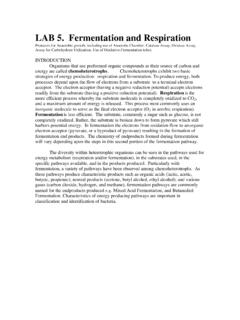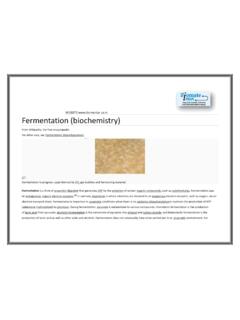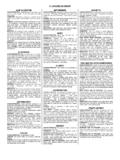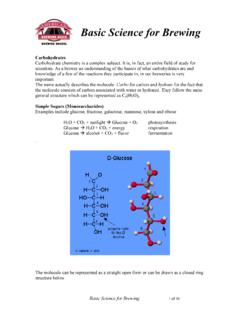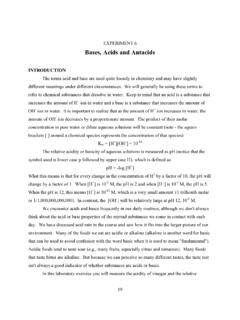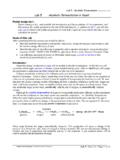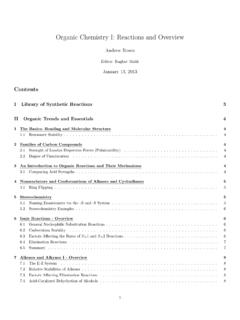Transcription of Animal Nutrition Handbook Section 3: Rumen …
1 Animal Nutrition HandbookSection 3: Rumen microbiology & FermentationPage 57 Rumen MICROBIOLOGYAND fermentation References: Allison (1993), Leek (1993), Bergman (1993) in "Dukes Physiology ofDomestic Animals" by Swenson & Reece, ed. (1993), " ,"and (Herbivorous strategies or utilization of forages in General; ) Professional Fermentors? - Two distinct strategies evolved for "professional fermentors" fermentors (or ruminants) - , Cattle, sheep, and )Have a large, multi-compartmented Section of the digestive tract between theesophagus & true )The forestomach can house a very complex ecosystem that supports fermentors, aka cecal digestors - , Horses & rabbits1)Similar to pigs & humans through the stomach and small )But, their large intestine, where fermentation takes place, is complex andexceptionally & differences?
2 1)The process and outcome of fermentation are essentially identical in the Rumen of acow or the cecum of a )However, the position of the " fermentation vat" in relation to the small intestinehas very important implications for the Animal 's physiology and )Summary?FunctionAbility to efficiently digest and extract energy from celluloseYesYesAbility to utilize dietary hexose sources directlyNoYesAbility to utilize the protein from fermentative microbesYesNo Remember? The small intestine is the only site where simple sugars andamino acids can be absorbed in all animals!?Copyright 2014 by Lee I. ChibaAnimal Nutrition HandbookSection 3: Rumen microbiology & FermentationPage 584)Utilization of dietary starch?
3 A)Horses? - Starch to glucose by amylase & maltase in the SI, and glucose isabsorbed into )Ruminants? - Very little is absorbed as glucose, and starch & others arefermented to VFA in the )Protein?a)The bodies of microbes can be a source of high quality protein!b)Because the fermentation vat of a horse is behind the small intestine, all theirmicrobial protein is lost - ?c)Ruminants - Microbes can flow into the stomach and small intestine, wherethey are digested and absorbed as amino acids and small OF THE tracts of ruminant species (& also others)? - Colonized by a diversity ofmicroorganisms, and the use of fibrous feedstuffs by microbes depends on themetabolic activities anaerobic microbes in the Rumen and the large & large intestine?
4 - Occupied by highly concentrated populations of bacteria,and also by protozoa and anaerobic tract? - Perhaps, the most intimate environment that animals areexposed to, and has a profound impact on the physiology and health of the host the simple stomach species? - Before reaching the acidic stomach, fermentation islimited to the ethanolic or lactic acid type, which may have minor impacts on thenutrition of the Animal (.. obviously, some exception though!).BForestomach fermentation ? - Occur at nearly neutral pH, and may be separated from theacidic :1)Are the most diverse (about 155 species) and best known of the herbivores withextensive forestomach fermentation )But, there are also others such as Camelidae (camel, llama, alpaca, guanaco, andvicuna), hippopotamuses, tree sloths (Cholopus and Bradypus), and :1)A fermentation chamber, in which bacteria and protozoa are 2014 by Lee I.
5 ChibaAnimal Nutrition HandbookSection 3: Rumen microbiology & FermentationPage 592)Can convert plant materials to volatile fatty acids (VFAs), methane, carbondioxide, ammonia, and microbial advantages of fermentation in the reticulorumen?1)Allows digestion and then absorption of fermentation products that are of value tothe host ( , microbial cells, VFAs, and B vitamins) before the acidic poor quality protein/N compounds to a "good-quality" microbial )Selective retention of coarse particles extends fermentation time and allows forfurther mechanical breakdown during rumination (cud chewing).4)Release of fermentation gas (mostly CO2 & CH4) from the system by )Toxic substances in the diet may be attacked by the microbes before beingpresented to the small information?
6 - Obtained mostly from studies of cattle and on wild ruminants is largely limited to that obtained by microscopicobservations, but predominant bacteria species in Rumen contents of deer, reindeer, elk,and moose are ones also found in cattle and sheep (based on cultural studies). bacterial species in cattle and sheep and their fermentative properties:1)Fermentative properties of ruminal bacteria: (Hespell, 1981) Species Function*Products Fibrobacter (Bacteroides) succinogenes C,A F,A,SRuminococcus albus C,X F,A,E,H,CRuminococcus flavefaciens C,X F,A,S,HButyrivibrio fibrisolvens C,X,PR F,A,L,B,E,H,CClostridium lochheadii C,PR F,A,B,E,H,CStreptococcus bovis A,S,SS,PR L,A,FRuminobacter (Bacteroides) amylophilus A,P,PR F,A,SPrevotella (Bacteroides)
7 Ruminocola A,X,P,PR F,A,P,SSuccinimonas amylolytica A,D A,SSelenomonas ruminantium A,SS,GU,LU,PRA,L,P,H,CLachnospira multiparus P,PR,A F,A,E,L,H,CSuccinivibrio dextrinosolvens P,D F,A,L,SMethanobrevibacter ruminantium M,HU MMethanosarcina barkeriM,HU MCTreponema bryantii P,SS F,A,L,S,EMegasphaera elsdenii SS,LU A,P,B,V,CP,H,CLactobacillus sp. SSLA naerovibrio lipolytica L,GU A,P,SEubacterium ruminantium SSF,A,B,COxalobacter formigenesOF,CWolinella succinogenes HU S,C * C = cellulolytic; X = xylanolytic; A = amylolytic; D = dextrinolytic; P = pectinoiytic; PR =proteolytic; L = lipolytic; M = methanogenic; GU = glycerol-utilizing; LU = lactate-utilizing; SS = major soluble sugar fermenter, HU = hydrogen utilizer; O = 2014 by Lee I.
8 ChibaAnimal Nutrition HandbookSection 3: Rumen microbiology & FermentationPage 60 F = formate; A = acetate; E = ethanol; P = propionate; L = lactate; B = butyrate; S =succinate; V = valerate; CP = caproate; H = hydrogen; C = carbon dioxide; M = )All of these bacteria are anaerobes & most are carbohydrate fermenters - Includinggram-negative and gram-positive cells, sporeformers and non-sporeformers, andmotile and nonmotile )Obligatory anaerobic mycoplasmas (.. cells enclosed by membranes rather thanby rigid walls):a)Some interest because detected only in Rumen & can ferment starch and )But, minor in terms of proportions relative to total population components,and heir contributions would be and relative volumes of bacteria and protozoa:1)Approximate average volumes and numbers of microbial groups in the Rumen ofsheep: (Warner, 1962) OrganismAvg.
9 Cell volumeNumber/mL% of total* Ciliate protozoaIsotricha, Epidinium, Diplodinium ,000, x , Diplodinium sp. 100, x sp. 10, x fungal zoospores x and fungal zoospores x x bacteria x *Total microbial volume was about mi per milliliter of Rumen )Protozoa are far less numerous than bacteria, but they are so much larger than thebacteria that they may occupy a volume nearly equal to that occupied by thebacteria.:a)Most important ones are anaerobic ciliates that are differentiated on the basisof morphology. Most of them belong to two, "holotrichous &entodiniomorphid" )Numbers and kinds of protozoa are markedly affected by diet, and thevariability among protozoa populations tends to be greater than the - An open ecosystem, and it is a dynamic system because conditions arecontinually changing ( ).
10 Copyright 2014 by Lee I. ChibaAnimal Nutrition HandbookSection 3: Rumen microbiology & FermentationPage 611)Each milliliter of Rumen content contains roughly:a)10 to 50 billion bacteria,b)1 million protozoa, andc)Variable numbers of yeasts and )The environment of the Rumen :a)Anaerobic, and as expected, almost all these microbes are anaerobes orfacultative )Fermentative microbes interact & support one another in a complex food web,with waste products of some species serving as nutrients for other )Bacteria? - Although many bacteria utilize multiple substrates, some of the majorgroups, each of which contain multiple genera and species, include:Cellulolytic - Digest cellulose Hemicellulolytic - Digest hemicellulose Amylolytic - Digest starch Proteolytic - Digest proteins Sugar utilizing - Utilize monosaccharides and disaccharides Acid utilizing - Utilize lactic, succinic, malic acids, etc.
